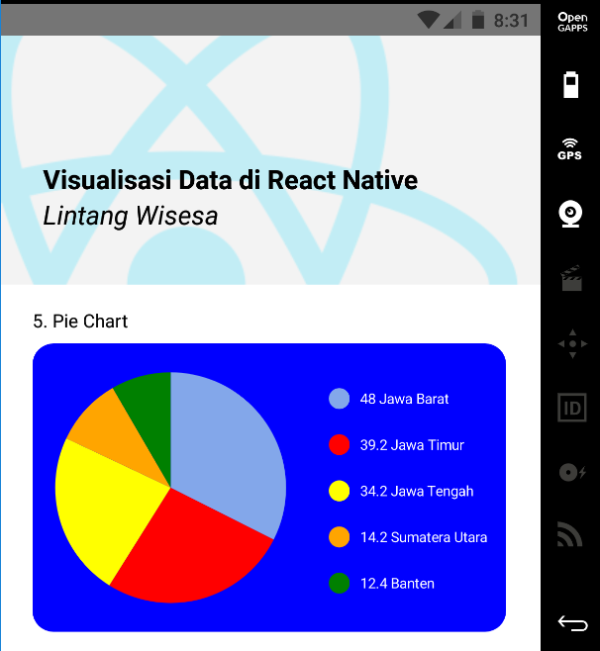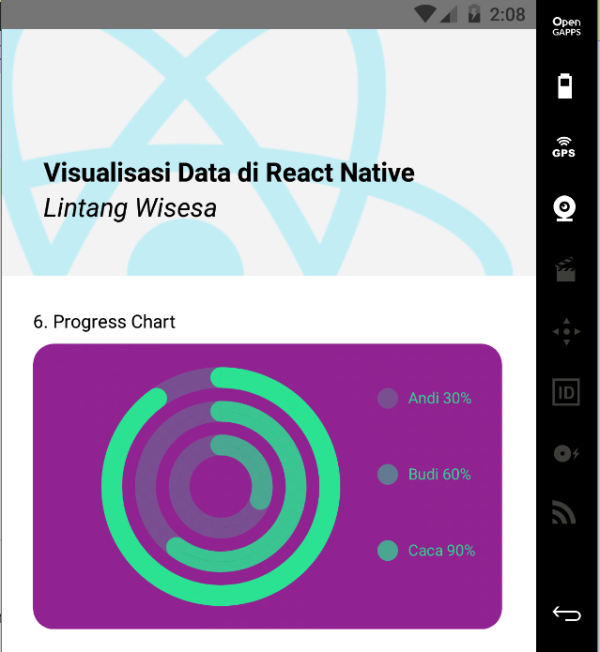-
Create a React Native project (I'm using the latest RN 0.61.2 and Genymotion as Android emulator), then install react-native-chart-kit and react-native-svg package.
$ npm i react-native-chart-kit react-native-svg
Then import it, so you can use it to create several charts on your React Native application.
import { LineChart, BarChart, PieChart, ProgressChart, ContributionGraph, StackedBarChart } from "react-native-chart-kit";
-
Create a Line Chart
<LineChart data={{ labels: ["Januari", "Februari", "Maret", "April", "Mei", "Juni"], datasets: [ { data: [ Math.random() * 100, Math.random() * 100, Math.random() * 100, Math.random() * 100, Math.random() * 100, Math.random() * 100 ] } ] }} width={Dimensions.get("window").width - 50} // from react-native height={220} yAxisLabel={"Rp"} chartConfig={{ backgroundColor: "red", backgroundGradientFrom: "red", backgroundGradientTo: "red", decimalPlaces: 2, // optional, defaults to 2dp color: (opacity = 1) => `white`, labelColor: (opacity = 1) => `white`, style: { borderRadius: 16 } }} style={{ marginVertical: 8, borderRadius: 16 }} />
-
Create a Bezier Line Chart
<LineChart data={{ labels: ["Januari", "Februari", "Maret", "April", "Mei", "Juni"], datasets: [ { data: [ Math.random() * 100, Math.random() * 100, Math.random() * 100, Math.random() * 100, Math.random() * 100, Math.random() * 100 ] } ] }} width={Dimensions.get("window").width - 50} // from react-native height={220} yAxisLabel={"Rp"} chartConfig={{ backgroundColor: "#e26a00", backgroundGradientFrom: "#fb8c00", backgroundGradientTo: "#ffa726", decimalPlaces: 2, // optional, defaults to 2dp color: (opacity = 1) => `white`, labelColor: (opacity = 1) => `white`, style: { borderRadius: 16 } }} bezier style={{ marginVertical: 8, borderRadius: 16 }} />
-
Create a Bar Chart
<BarChart data={{ labels: ["Januari", "Februari", "Maret", "April", "Mei", "Juni"], datasets: [ { data: [ Math.random() * 100, Math.random() * 100, Math.random() * 100, Math.random() * 100, Math.random() * 100, Math.random() * 100 ] } ] }} width={Dimensions.get("window").width - 50} // from react-native height={220} yAxisLabel={"Rp"} chartConfig={{ backgroundColor: "yellow", backgroundGradientFrom: "yellow", backgroundGradientTo: "yellow", decimalPlaces: 2, // optional, defaults to 2dp color: (opacity = 1) => `black`, labelColor: (opacity = 1) => `black`, barPercentage:1, style: { borderRadius: 16 } }} style={{ marginVertical: 8, borderRadius: 16 }} />
-
Create a Stacked Bar Chart
<StackedBarChart data={{ labels: ["Test1", "Test2"], legend: ["L1", "L2", "L3"], data: [[60, 60, 60], [30, 30, 60]], barColors: ["#dfe4ea", "#ced6e0", "#a4b0be"] }} width={Dimensions.get("window").width - 50} // from react-native height={220} yAxisLabel={"Rp"} chartConfig={{ backgroundColor: "green", backgroundGradientFrom: "green", backgroundGradientTo: "green", decimalPlaces: 2, // optional, defaults to 2dp color: (opacity = 1) => `white`, labelColor: (opacity = 1) => `white`, style: { borderRadius: 16 } }} style={{ marginVertical: 8, borderRadius: 16 }} />
-
Create a Pie Chart
<PieChart data={ [ { name: "Jawa Barat", population: 48.0, color: "rgba(131, 167, 234, 1)", legendFontColor: "white", legendFontSize: 11 }, { name: "Jawa Timur", population: 39.2, color: "red", legendFontColor: "white", legendFontSize: 11 }, { name: "Jawa Tengah", population: 34.2, color: "yellow", legendFontColor: "white", legendFontSize: 11 }, { name: "Sumatera Utara", population: 14.2, color: "orange", legendFontColor: "white", legendFontSize: 11 }, { name: "Banten", population: 12.4, color: "green", legendFontColor: "white", legendFontSize: 11 } ] } width={Dimensions.get("window").width - 50} // from react-native height={220} chartConfig={{ color: (opacity = 1) => `white`, labelColor: (opacity = 1) => `white`, style: { borderRadius: 16 } }} backgroundColor="blue" accessor="population" paddingLeft="15" absolute style={{ marginVertical: 8, borderRadius: 16 }} />
-
Create a Progress Chart
<ProgressChart data={ { labels: ["Andi", "Budi", "Caca"], data: [0.3, 0.6, 0.9] } } width={Dimensions.get("window").width - 50} // from react-native height={220} chartConfig={ { backgroundGradientFrom: 'purple', backgroundGradientFromOpacity: 1, backgroundGradientTo: 'purple', backgroundGradientToOpacity: 0.5, color: (opacity = 1) => `rgba(26, 255, 146, ${opacity})`, strokeWidth: 2, // optional, default 3 } } backgroundColor="green" paddingLeft="15" absolute style={{ marginVertical: 8, borderRadius: 16 }} />
-
Create a Contribution Graph
<ContributionGraph values={ [ { date: "2017-01-02", count: 1 }, { date: "2017-01-03", count: 2 }, { date: "2017-01-04", count: 3 }, { date: "2017-01-05", count: 4 }, { date: "2017-01-06", count: 5 }, { date: "2017-01-30", count: 2 }, { date: "2017-01-31", count: 3 }, { date: "2017-03-01", count: 2 }, { date: "2017-04-02", count: 4 }, { date: "2017-03-05", count: 2 }, { date: "2017-02-30", count: 4 } ] } endDate={new Date('2017-04-01')} numDays={105} width={Dimensions.get("window").width - 50} // from react-native height={220} chartConfig={ { backgroundGradientFrom: 'pink', backgroundGradientFromOpacity: 0.5, backgroundGradientTo: 'red', backgroundGradientToOpacity: 0.5, color: (opacity = 1) => `rgba(255, 0, 0, ${opacity})`, strokeWidth: 2, // optional, default 3 } } paddingLeft="15" style={{ marginVertical: 8, borderRadius: 16 }} />
Lintang Wisesa 💌 lintangwisesa@ymail.com
Facebook | Twitter | Google+ | Youtube | :octocat: GitHub | Hackster







